Paintings based on the works of Russian writers. Russian history in the paintings of artists
A. Ivanov. Appearance of the Risen Christ to Mary Magdalene .
A. Ivanov. Appearance of Christ to the People
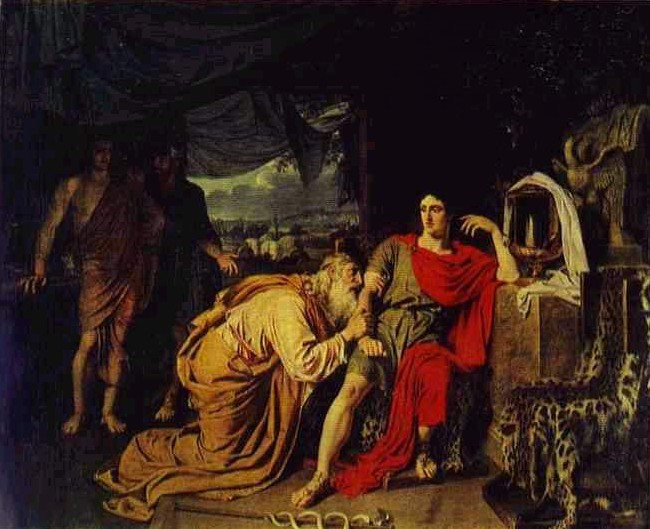
A. Ivanov. Priam asks Achilles to return Hector's body. 1824
A. Ivanov. Bellerophon going to war with the Chimera.
Ivan Nikolaevich Kramskoy (1837, Ostrogozhsk - 1887, St. Petersburg)
Born in the family of a clerk. Created a number of portraits of prominent Russian writers, artists and public figures such as: Lev Nikolaevich Tolstoy, Shishkin Ivan Ivanovich, Pavel Mikhailovich Tretyakov, Saltykov-Shchedrin, Mikhail Evgrafovich - all are in the Tretyakov Gallery, the portrait of Botkin is a private collection. One of Kramskoy's most famous works is "Christ in the Desert" written in 1872.
The artist died on March 24, 1887, while working on a portrait of Dr. Rauchfuss, when he suddenly stooped and fell. Rauhfus tried to help him, but it was too late. 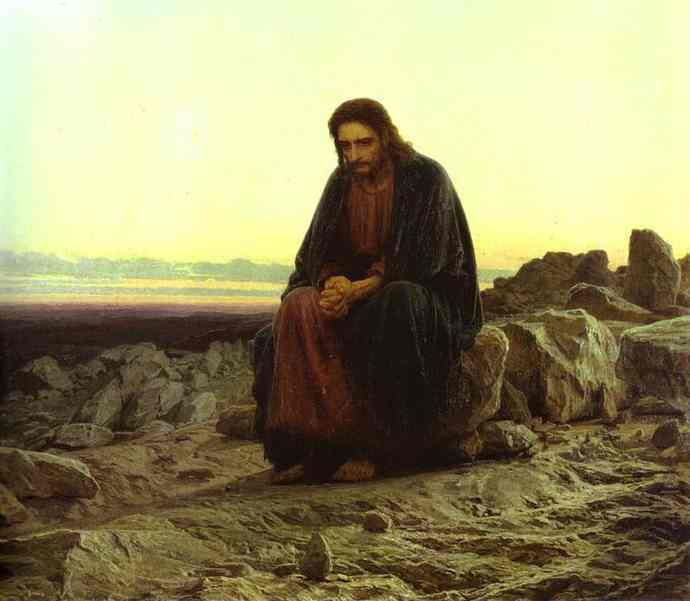
Christ in the Desert, 1872
![]()
Herodias, 1886
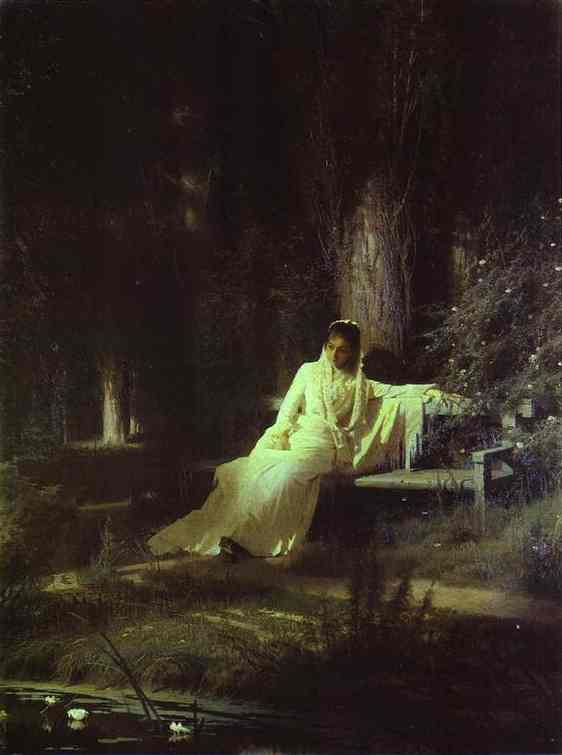
I. Kramskoy. Moonlight night. 1880

I. Kramskoy. May night. 1871
Polenov Vasily Dmitrievich.( 1844-1927)
Born in St. Petersburg on May 20 (June 1), 1844 in the family of archaeologist DV Polenov. He studied at the St. Petersburg Academy of Arts (1863-1871) and in parallel - at the Faculty of Law of St. Petersburg University. He took private lessons from P.P. Chistyakov and I.N. Kramskoy. Visited in 1872-1876 Italy, France and Germany as a "pensioner" of the Academy of Arts; traveled a lot later, having visited, in particular, the Middle East and Greece (1881-1882, 1899 and 1909). Participated as a volunteer in the Serbo-Montenegrin-Turkish war of 1877-1878, created many battle and ethnographic sketches and sketches. He was a member of the Association of Wanderers.
Polenov died in his estate-museum Borok (since 1931 - Polenovo) on July 18, 1927.
Christ and the Sinner, 1888

V. Polenov. family scene. 1876

V. Polenov. Arrest of a Huguenot. 1875
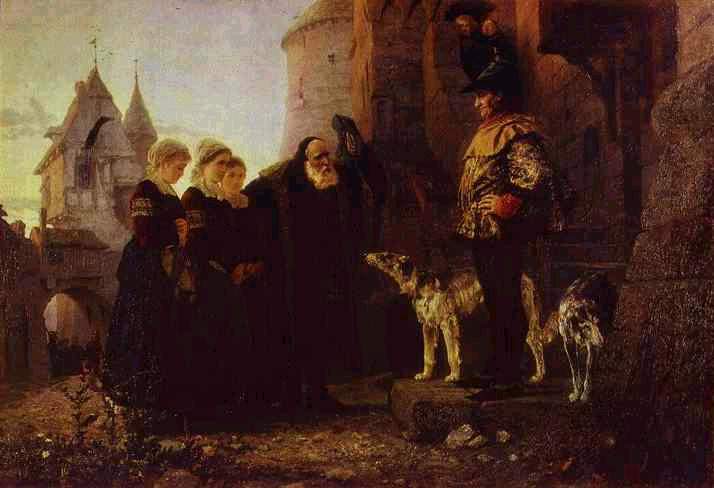
V. Polenov. Seigniorage. 1874
Sick, 1886
Tyranov Alexey Vasilievich (1808-1859)
Born in the city of Bezhetsk in a bourgeois family. A. V. Tyranov is one of the most gifted students of A. V. Venetsianov, a portrait painter and genre painter.
In 1859 he died of consumption. 
A. Tyranov. Weavers.
SVEDOMSKY Pavel Alexandrovich(June 7, 1849 St. Petersburg-September 9, 1904 Switzerland)
Educated at the Dusseldorf Academy of Arts (1870), studied in the workshop of M. Munkacsy in Munich, settled in Rome, where he lived all his life. (Note that he performed all these actions together with his older brother for only a year and also an artist - Alexander Svedomsky.) The artist worked on his paintings in Rome, regularly sending them to exhibitions in St. Petersburg and other European cities, where he often received medals for their canvases. Still, there were years when P.A. Svedomsky appeared in St. Petersburg and even in his estate in the Perm province. A special place in his life and work is occupied by participation in the murals of the Vladimir Cathedral in Kyiv, where his contribution to common work significant.
P.A. Svedomsky was an artist European level, an academician by education and main creative direction. 
P. Svedomsky. Roman woman at the pond. 1888

P. Svedomsky. Maria Hamilton before her execution. 1904
Postnikov Sergey Petrovich(1826 Moscow - April 9, 1880 Rome)
He received his artistic education at the Moscow School of Painting, Sculpture and Architecture. After him, he studied at the Academy of Arts for three years (1855-1858).
S. Postnikov goes to Rome at his own expense and spends five years there in hard work. Upon returning to his homeland, two of the many paintings he brought with him from Italy - “Farewell of Hector to Andromache” and “Bacchante with a Tambourine” - served as the reason for awarding the artist the title of academician (1863) of historical painting. 
S. Postnikov. Farewell of Hector to Andromache. 1863
Tupylev Ivan Filippovich(1758-1821)
historical painter and portrait painter, graduate of the Imperial Academy of Arts since 1764
Improved in Paris. Upon his return to St. Petersburg, he received the titles: appointed to the academician in 1785, academician and associate professor in 1794, and, finally, professor, in 1800. He was the director of the Imperial Tapestry Manufactory. He painted exclusively images and portraits of the royal family and other noble persons. 
I. Tupylev. Alexander the Great before Diogenes. 1787
Rogue game.
Ivan Akimovich Akimov(May 22 (June 2) 1755, St. Petersburg - May 15 (27), 1814, St. Petersburg),
Russian painter, representative of classicism.
The son of a typesetter at the Senate Printing House, ten years old, wrote an application for admission to the Academy of Arts, outlining the unfortunate circumstances and poverty of his life, and was accepted as a pupil.
Ivan Akimovich was perhaps one of the first historiographers of Russian art. Well-known is his article “Brief historical news about some Russian artists.

Grand Duke Svyatoslav kissing his mother and children upon his return from the Danube to Kyiv. 1773,
Tretyakov Gallery, Moscow
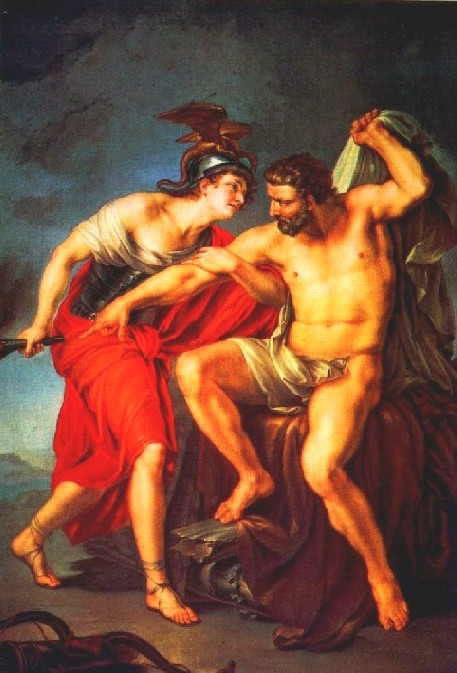
I. Akimov. Self-immolation of Hercules at the stake in the presence of his friend Philoctetes. 1782
Sergey Ivanovich Vasilkovsky(October 7, 1854, Izyum, Kharkov province - October 8, 1917, Kharkov)
- Russian and Ukrainian landscape painter.
Sergei received his first skills in fine arts at the Kharkov gymnasium, his teacher was D. I. Bezperchiy (1825-1913) - a former serf, a classmate of Taras Shevchenko in the workshop of Karl Bryullov. From 1876 to 1885 he studied at the St. Petersburg Imperial Academy of Arts, in the landscape class of M. K. Klodt (1832-1902) and V. D. Orlovsky (1842-1914). Vasilkovsky graduated from the Academy of Arts with a large gold medal.
The artist Sergei Vasilkovsky left almost 3,000 works; in the last days of his life, one and a half thousand of them he handed over to the Kharkov Art Museum. Unfortunately, most of them died during the Great Patriotic War, and today there are about 500 of his works in museums and private collections.
Kovalevsky Pavel Osipovich (1843-1903)
The son of a Kazan University professor, Pavel Osipovich Kovalevsky, who had a penchant for painting, chose a battle class when he entered the Academy of Arts in 1863. By that time, certain traditions of teaching battle painting had already developed at the Academy, a powerful impetus for the development of which was given by Patriotic War 1812. After graduating under the guidance of B.P. Villevalde Academy, the artist in his retirement trip to Italy for the painting "Excavations in the vicinity of Rome" (1867) received the title of academician.
In the 1880s, sketches of the Balkan campaign were used by P.O. Kovalevsky when writing canvases for the Military Gallery of the Winter Palace. Although the artist also painted genre scenes (for example, Detour of the Diocese, 1885), his affection was determined in childhood. That is why the professor (1881) of the Academy of Arts P.O. Kovalevsky, having headed the battle workshop of the Academy of Arts in 1897, directed it and future battle painters until his last days. 
P. Kovalevsky. Tour of the diocese.
Nikolai Alekseevich Kasatkin(December 13 (25), 1859, Moscow - December 17, 1930, Moscow)
- Russian realist painter, member of the "Association of the Wanderers" since 1891, the first people's artist of the RSFSR (1923), one of the founders of socialist realism.
He graduated from the School of Painting, Sculpture and Architecture (1873-1883), where his main mentor was V. G. Perov. 
Rivals, 1890
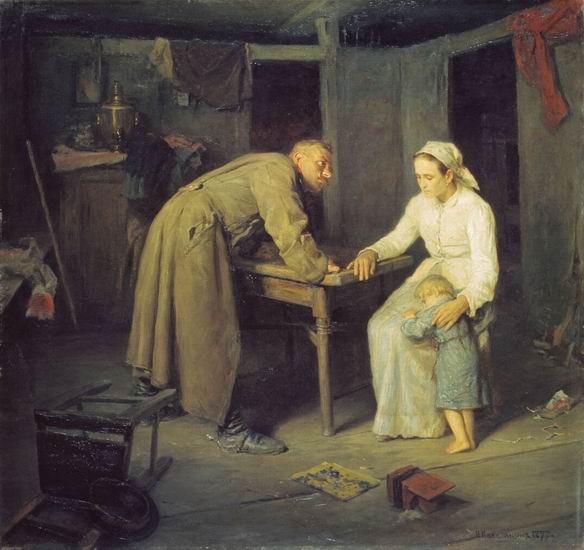
Who! 1897

In the corridor of the district court, 1897

N. Kasatkin. In a working family. 1900
Krendovsky Evgraf Fedorovich(1810-1854)
In 1830 he came to St. Petersburg to continue his studies at the school of A.G. Venetsianov. E. Krendovsky's final painting at the Academy was the painting "The Throne Room of Empress Maria Feodorovna in the Winter Palace" (1835). In 1836 E.F. Krendovsky leaves for his small homeland- to Kremenchug, where he lives and works on the estate of the landowner V.M. Ostrogradskaya. He teaches drawing and painting to the children of the owner of the estate and paints pictures. Quite a bit of the work done by the artist has come down to us - a little more than twenty of his paintings. Since 1854, there is no information about the artist. 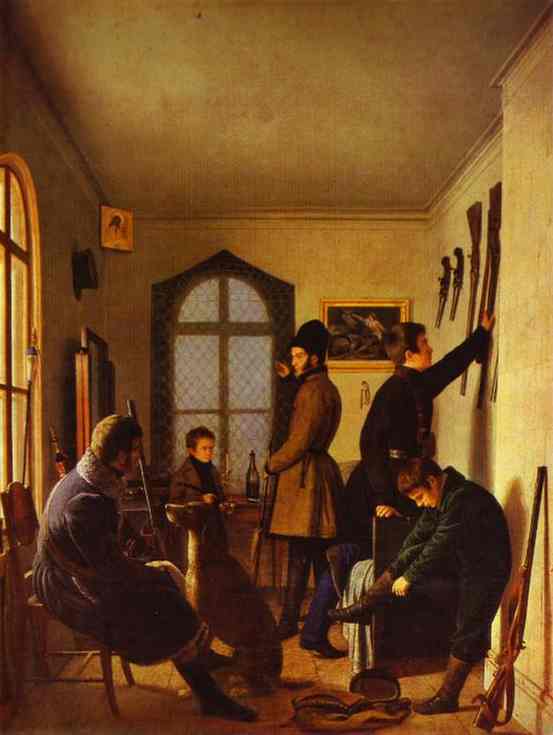
E. Krendovsky. Preparations for the hunt. 1836
Basin Petr Vasilyevich (1793-1877)
The work of P.V. Basin is typical for the artist of the Russian academic school of the middle of the 19th century. Basin was associated with the St. Petersburg Academy of Arts almost all his life. Big gold medal, received for the painting "Christ drives out the merchants from the temple" (1818), gave him the right to a pensioner's trip to Italy.
At home, Basin almost immediately began teaching at the Academy of Arts and successfully engaged in this activity for almost forty years (1831-69), regularly receiving orders and the next rank. He retired as an honored professor of the 1st degree in history and portrait painting, a real state adviser. He did not create anything bright, outstanding in these years. He painted several good portraits: his wife O. V. Basina (1837-38), who died early, Yu. P. Samoilova (1839), six of his children (mid-1850s), etc. The attic of the building of the Academy of Arts" (early 1830s). 
P. Basin. The attic of the building of the Academy of Arts. 1831
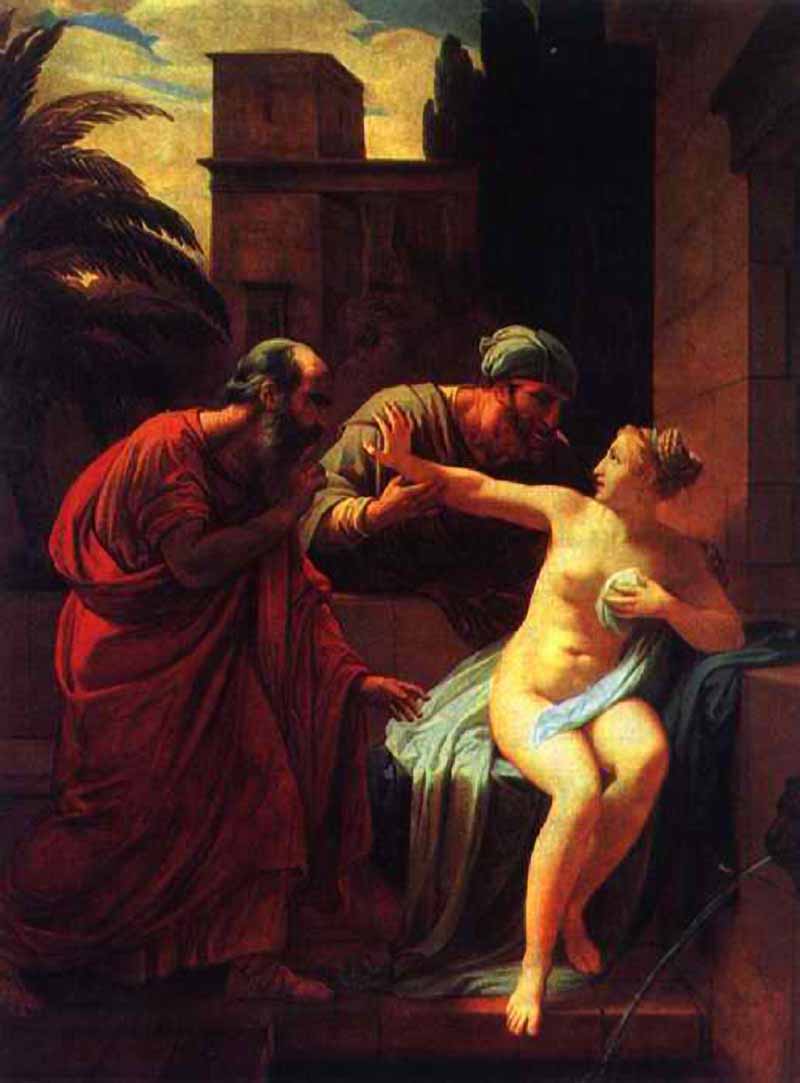
Susanna caught by the elders in the pool. 1822
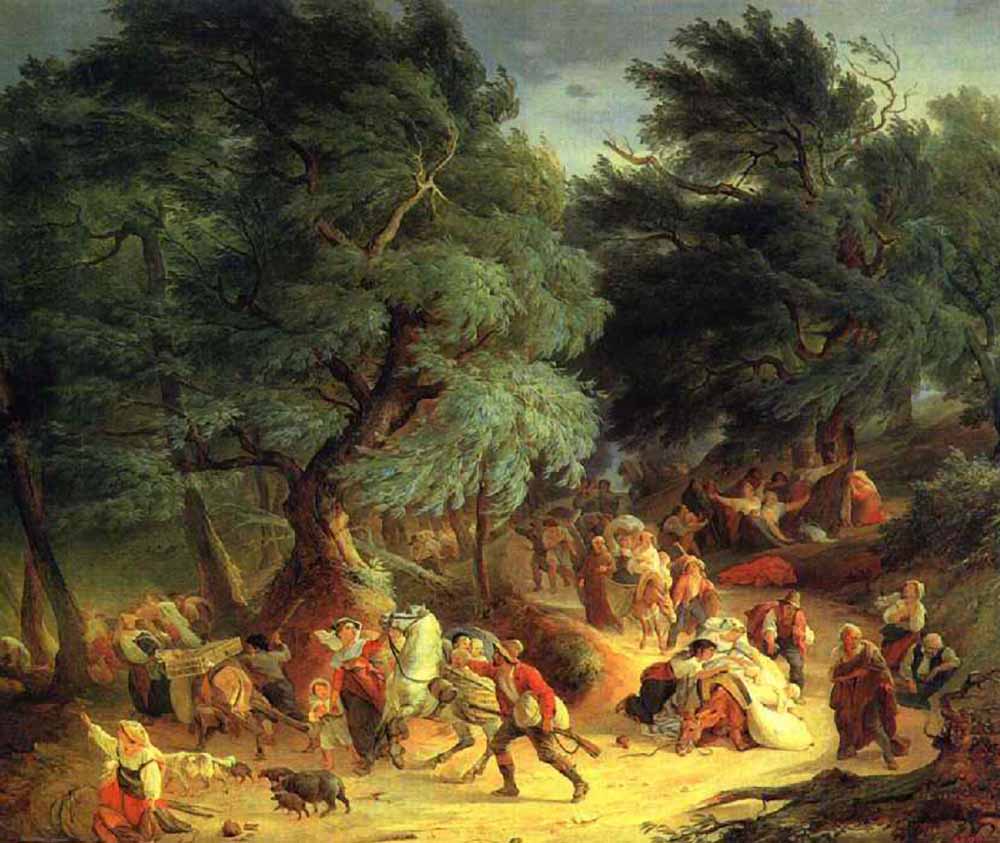
Earthquake in Rocca di Papa, near Rome. 1830
Mikhail Shibanov(patronymic and year of birth unknown - died after 1789),
Russian artist, painter from serfs. Since 1783 "free painter". Portrait painter, pioneer of the peasant household genre in Russian art.
It is known for certain that the artist made images and painted iconostases for churches in the southern cities of Russia. Some paintings by M. Shibanov of the second half of the 18th century are known. 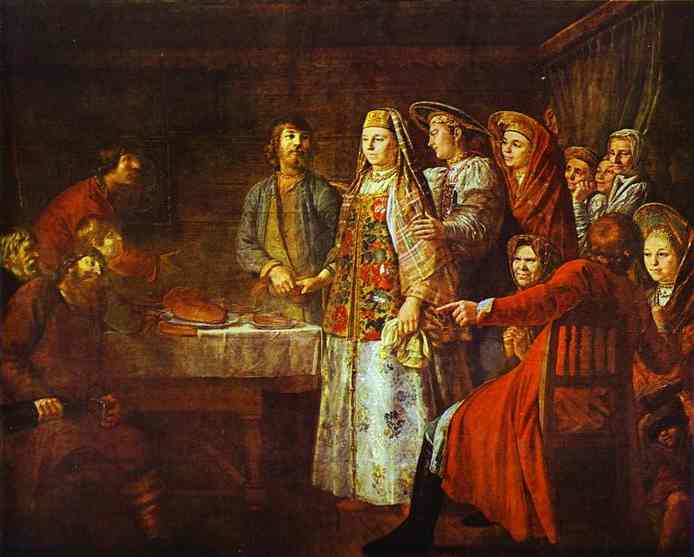
M. Shibanov. Marriage contract. 1777

M. Shibanov. Peasant lunch. 1774
Since time immemorial, people have always admired nature. They expressed their love by depicting it in all kinds of mosaics, bas-reliefs and paintings. Many great artists have devoted their creativity to painting landscapes. Pictures depicting forests, sea, mountains, rivers, fields are truly mesmerizing. And you need to respect the great masters, who in such detail, colorfully and emotionally conveyed in their works all the beauty and power of the world around us. It is landscape painters and their biographies that will be discussed in this article. Today we will talk about the work of the great painters of different times.
Notable landscape painters of the 17th century
In the 17th century, there were many talented people who preferred to depict the beauties of nature. Some of the most famous are Claude Lorrain and Jacob Isaac van Ruisdael. With them we will begin our story.
Claude Lorrain
The French artist Claude Lorrain is considered the founder of the landscape of the Classicist period. His canvases are distinguished by incredible harmony and perfect composition. hallmark K. Lorrain's technique was the ability to flawlessly convey sunlight, its rays, etc.
Despite the fact that the maestro was born in France, he spent most of his life in Italy, where he left when he was only 13 years old. He returned to his homeland only once, and then for two years.
by the most famous works K. Lorrain are paintings "View of the Roman Forum" and "View of the port with the Capitol". Today they can be seen in the Louvre.
Jacob Isaac van Ruisdael
Jacob van Ruysdael - a representative of realism - was born in Holland. During his travels in the Netherlands and Germany, the artist created many remarkable works, which are characterized by a sharp contrast of tones, dramatic colors and coldness. One of the brightest examples of such paintings can be considered the European Cemetery.
However, the artist's work was not limited to gloomy canvases - he also depicted rural landscapes. The most famous works are considered to be “View of the village of Egmond” and “Landscape with a water mill”.

18th century
Much is characteristic of 18th century painting. interesting features, during this period, new directions were laid in the mentioned art form. Venetian landscape painters, for example, worked in such areas as landscape (another name - leading) and architectural (or urban). And the leading landscape, in turn, was divided into accurate and fantastic. A prominent representative of the fantastic veduta is Francesco Guardi. Even modern landscape painters can envy his fantasies and technique of execution.
Francesco Guardi
Without exception, all his works are distinguished by impeccably accurate perspective, remarkable color reproduction. Landscapes have a certain magical appeal, it is simply impossible to take your eyes off them. 
The most delightful of his works can be called canvases " holiday ship Doge's "Bucintoro", "Gondola in the Lagoon", "Venetian Courtyard" and "Rio dei Mendicanti". All his paintings depict views of Venice.
William Turner
This artist is a representative of romanticism.
A distinctive feature of his paintings is the use of many shades of yellow. It was the yellow palette that became the main one in his works. The master explained this by the fact that he associated such shades with the sun and the purity that he wanted to see in his paintings.
Turner's most beautiful and mesmerizing work is the Garden of the Hesperides, a fantastic landscape.
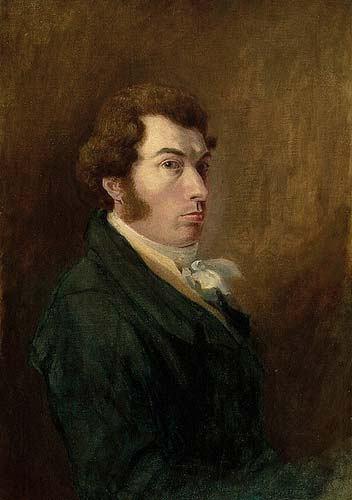
Ivan Aivazovsky and Ivan Shishkin
These two men are truly the greatest and most famous artists landscape painters of Russia. The first - Ivan Konstantinovich Aivazovsky - depicted the majestic sea in his paintings. Violence of the elements, rising waves, splashes of foam crashing against the side of a tilted ship, or a quiet, serene expanse illuminated by the setting sun - sea landscapes delight and amaze with their naturalness and beauty. By the way, such landscape painters are called marine painters. The second - Ivan Ivanovich Shishkin - loved to depict the forest.
Both Shishkin and Aivazovsky are landscape painters of the 19th century. Let us dwell on the biography of these personalities in more detail.
In 1817, one of the most famous marine painters in the world, Ivan Aivazovsky, was born.

He was born into a wealthy family, his father was an Armenian businessman. There is nothing surprising in the fact that the future maestro had a weakness for the sea. After all, Feodosia, a beautiful port city, became the birthplace of this artist.
In 1839 Ivan graduated from where he studied for six years. The artist's style was greatly influenced by the work of the French marine painters C. Vernet and C. Lorrain, who painted their canvases according to the canons of baroque-classicism. most famous work I. K. Aivazovsky is considered the painting "The Ninth Wave", made in 1850.
In addition to seascapes, great artist worked on the image of battle scenes (a vivid example is the painting “Chesme Battle”, 1848), and also devoted many of his canvases to the themes of Armenian history (“Visit by J. G. Byron to the Mekhitarist Monastery near Venice”, 1880). 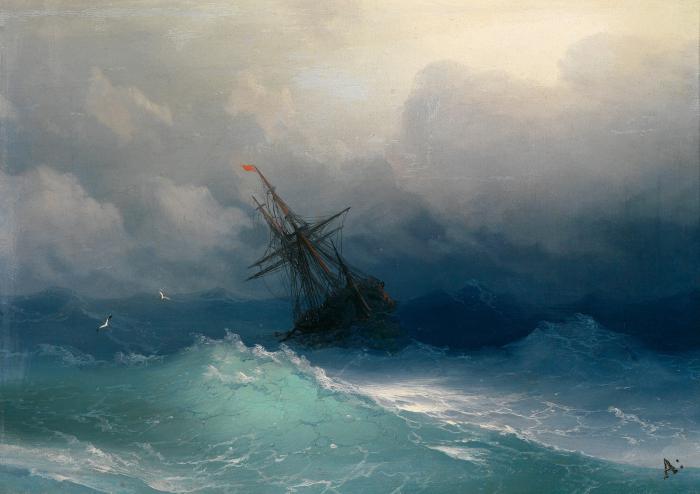
Aivazovsky was lucky to achieve incredible fame during his lifetime. Many landscape painters who became famous in the future admired his work and took an example from him. The great creator passed away in 1990.
Shishkin Ivan Ivanovich was born in January 1832 in the city of Yelabuga. The family in which Vanya was brought up was not very prosperous (his father was a poor merchant). In 1852, Shishkin began his studies at the Moscow School of Painting, Sculpture and Architecture, from which he would graduate four years later, in 1856. Even the earliest works of Ivan Ivanovich are distinguished by their extraordinary beauty and unsurpassed technique. Therefore, it is not surprising that in 1865 I. I. Shishkin was given the title of academician for the painting “View in the vicinity of Dusseldorf”. And after eight years he received the title of professor. 
Like many others, he painted from nature, spending a long time in nature, in places where no one could disturb him.
The most famous canvases of the great painter are “Wilderness” and “Morning in a Pine Forest”, written in 1872, and the earlier painting “Noon. In the vicinity of Moscow "(1869)
The life of a talented person was interrupted in the spring of 1898. 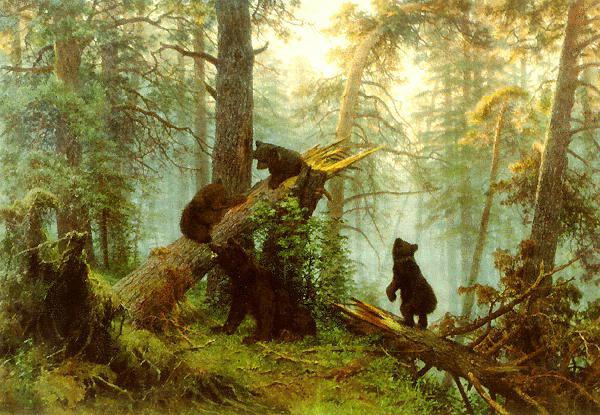
Many Russian landscape painters use a large amount of detail and colorful color reproduction when writing their canvases. The same can be said about these two representatives of Russian painting.
Alexey Savrasov
Alexei Kondratievich Savrasov is a world-famous landscape painter. It is he who is considered the founder of the Russian lyrical landscape. 
This outstanding person was born in Moscow in 1830. Since 1844, Alexei began his studies at the Moscow School of Painting and Sculpture. Already from his youth, he was distinguished by a special talent and ability to depict landscapes. However, despite this, for family reasons, the young man was forced to interrupt his studies and resume it only four years later.
The most famous and beloved work of Savrasov is, of course, the canvas "The Rooks Have Arrived". It was presented at the Traveling Exhibition in 1971. No less interesting are the paintings by I. K. Savrasov "Rye", "Thaw", "Winter", "Country Road", "Rainbow", "Moose Island". However, according to critics, none of the artist's works can be compared with his masterpiece The Rooks Have Arrived.
Despite the fact that Savrasov painted many beautiful paintings and was already known as the author of wonderful paintings, he was soon forgotten for a long time. And in 1897 he died in poverty, driven to despair by family troubles, the death of children and alcohol addiction. 
But the great landscape painters cannot be forgotten. They live in their paintings, the charm of which is breathtaking, and which we can still admire to this day.
Second half of the 19th century
This period is characterized by the prevalence in Russian painting of such a direction as everyday landscape. Many Russian landscape painters worked in this vein, including Makovsky Vladimir Yegorovich. No less famous masters of those times are Arseny Meshchersky, as well as the previously described Aivazovsky and Shishkin, whose work took place in the middle-second half of the 19th century.
Arseny Meshchersky
This famous artist was born in 1834 in the Tver province. He received his education at the Imperial Academy of Arts, where he studied for three years. The main themes of the author's canvases were forest and the Artist was very fond of depicting magnificent views of the Crimea and the Caucasus with their majestic mountains in his paintings. In 1876 he received the title of professor of landscape painting. 
The most successful and famous of his canvases can be considered the painting “Winter. Icebreaker”, “View of Geneva”, “Storm in the Alps”, “At the Forest Lake”, “Southern Landscape”, “View in the Crimea”.
In addition, Meshchersky also conveyed the beauty of Switzerland. In this country, for some time he gained experience with the master of landscape painting Kalam.
And the master was fond of sepia and engraving. In these techniques, he also created many remarkable works.
Many paintings by the artist in question were shown at exhibitions both in Russia and in other countries of the world. Therefore, many people managed to appreciate the talent and originality of this creative person. The paintings of Arseny Meshchersky continue to delight many people who are fond of art to this day.
Makovsky Vladimir Egorovich
Makovsky V. E. was born in Moscow in 1846. His father was a famous artist. Vladimir decided to follow in his father's footsteps and received an art education at the Moscow School of Painting, Sculpture and Architecture, after which he left for St. Petersburg.
His most successful paintings were “Waiting. At the prison”, “The collapse of the bank”, “Explanation”, “Bedroom house” and “Spring bacchanalia”. The works mainly depict ordinary people and domestic scenes. 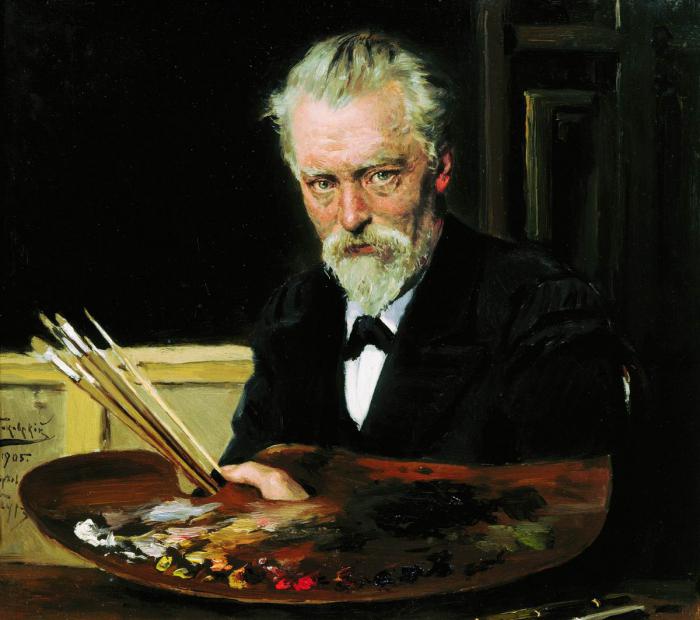
In addition to everyday landscapes, of which he was a master, Makovsky also painted portraits and various illustrations.
The page contains the most famous paintings by Russian artists of the 19th century with titles and descriptions
The diverse painting of Russian artists since the beginning of the 19th century attracts with its originality and versatility in the domestic fine arts. The masters of painting of that time did not cease to amaze with their unique approach to the plot and reverent attitude to the feelings of people, to their native nature. In the 19th century, portrait compositions were often painted with an amazing combination of an emotional image and an epicly calm motive.
The paintings of Russian artists are magnificent in craftsmanship and truly beautiful in perception, strikingly accurately reflected the breath of their time, the unique character of the people and their desire for beauty.
The canvases of Russian painters, which are the most popular: Alexander Ivanov is a bright representative of the picturesque biblical direction, telling us in colors about the episodes of the life of Jesus Christ.
Karl Bryullov is a popular painter in his time, his direction is historical painting, portrait themes, romantic works.
Marine painter Ivan Aivazovsky, his paintings are magnificent and one might say simply unsurpassedly reflect the beauty of the sea with transparent rolling waves, sea sunsets and sailboats.
Distinctive versatility stands out the work of the famous Ilya Repin, who created genre and monumental works that reflect the life of the people.
Very picturesque and large-scale paintings by the artist Vasily Surikov, the description of Russian history is his direction, in which the artist emphasized the episodes in colors life path Russian people.
Each artist is unique, for example, the picturesque master of fairy tales and epics Viktor Vasnetsov, unique in his style, is always juicy and bright, romantic canvases, the heroes of which are all of us famous heroes folk tales.
Each artist is unique, for example, the picturesque master of fairy tales and epics Viktor Vasnetsov, unique in his style, is always juicy and bright, romantic canvases, the heroes of which are the well-known heroes of folk tales. Very picturesque and large-scale paintings by the artist Vasily Surikov, the description of Russian history is his direction, in which the artist emphasized the episodes of the life path of the Russian people in colors.
In Russian painting of the 19th century, such a trend as critical realism also appeared, emphasizing ridicule, satire and humor in the plots. Of course, this was a new trend, not every artist could afford it. In this direction, such artists as Pavel Fedotov and Vasily Perov were determined.
Landscape painters of that time also occupied their niche, among them Isaac Levitan, Alexei Savrasov, Arkhip Kuindzhi, Vasily Polenov, the young artist Fyodor Vasiliev, the picturesque master of the forest, forest glades with pines and birches with mushrooms Ivan Shishkin. All of them colorfully and romantically reflected the beauty of Russian nature, the variety of forms and images of which is associated with the colossal potential of the surrounding world.
According to Levitan, in every note of Russian nature there is a unique colorful palette, hence there is a huge expanse for creativity. Perhaps this is the riddle that the canvases created in the vast expanses of Russia are distinguished by some exquisite severity, but at the same time, they attract with discreet beauty, from which it is difficult to look away. Or not at all intricate and rather not catchy plot, Levitan's painting Dandelions, as it were, encourages the viewer to think and see the beauty in the simple.
Russian paintings are unique masterpieces of world art. They are impossible to forget by everyone who happened to see them in museums. Artists created in various genres, but all their works are imbued with a sense of beauty and eternity. Therefore, in our busy, fast-paced age, when there is so little time, it is worth peering into one of these paintings, and you will find yourself in a cool oasis of calm, hope, joy and inspiration. After resting your soul, you will be ready to continue your journey, washing away the layer of daily worries and unnecessary fuss. Each person can find in these works not only amazing color, elegance of lines, but also the answer to the question about the very meaning of life.
1)
Man is inextricably linked with nature, he is a part of it. And the enjoyment of nature, the desire to find in it consonance with one's feelings, one's ideals, has always been a source of creativity for writers, composers, and artists. 2) LANDSCAPE(French - " locality, country"; lat.-" village, village) - genre, subject which image is nature, her transformation and relation expression artist to its environment; this genre is typical for painting and graphics, less common in sculpture (relief). As an independent genre, the landscape first appeared in China in the 6th century. 3) Varieties of landscape (subgenres):
rural, urban, architectural, industrial landscape.
AT …
a special subgenre stands out marina
- the image of the sea element.
4) In the 60-70s of the XIX century. arises and the Russian national landscape is approved, based on the conquest of artists of previous eras.5) founder his rightfully is Alexey Kondratievich Savrasov(1830-1897). 6) Continued and developed its traditions wonderful Russian landscape painters Fedor Alexandrovich Vasiliev(1850-1873), Ivan Ivanovich Shishkin(1832-1898), Arkhip Ivanovich Kuindzhi(1842-1910). 7) The pinnacle of Russian landscape art in the 60-90s of the 19th century. recognized creativity Isaac Ilyich Levitan (1850-1900).
In the 60s of the nineteenth century, a period of formation of realistic landscape painting began in Russia. The main role for landscape painters was acquired by the question of the content of art. Motivated by high patriotic feelings, they sought to show the mighty and fertile Russian nature as a source of possible wealth and happiness. At this time, individual works of landscape painters could already boldly stand in line with the paintings of genre painting, which at that time was the most advanced art. A significant contribution to the development of the Russian landscape was made by such famous artists as Alexei Savrasov, Ivan Shishkin, Fyodor Vasiliev, Arkhip Kuindzhi, Vasily Polenov, Isaac Levitan.
9) One of the most famous paintings in the history of the Russian landscape is considered to be modest in size and uncomplicated in motive. A.K.Savrasova “The Rooks Have Arrived” 1872 BUT) An unpretentious landscape of an ordinary Russian village. An old church with a bell tower, a long board fence, roofs of wooden houses, several thin, unsightly, twisted birches in the foreground, on which rooks that have arrived make their nests - everything on the canvas seems unusually simple and familiar. And how wonderful it all is at the same time! In spring, the air is clean and transparent, it seems to be filled with moisture. The snow has already become loose, thawed patches appear. One of them (on the right) reflects the blue sky, white clouds, bushes, thin trees. The landscape is painted with the most delicate mother-of-pearl combinations of colors, light, light, transparent. (it is possible to write epithets on the board). And if you carefully look at the picture for a long time, it will seem sounding: you can hear the soft chime of bells, the spring hubbub of fussy birds. B) The artist I.N.Kramskoy called the landscape “the best and really beautiful”, since it has the “soul” of Russian nature, its lyricism and sincerity. (It is possible to use a poster with written words of Kramskoy I.N.) C) The landscape of a small village has turned into an image of the Motherland, into an image of all of Russia.
*** In 1871, a young artist Fedor Alexandrovich Vasiliev after a trip along the Volga, a picture was painted "Thaw" . The feeling caused by the landscape is ambiguous, complex. This is a soul-piercing melancholy, loneliness: a plain open to the winds, a forest looks creepy against the background of a low leaden cloud; a snow-covered peasant hut, standing off the road, seems abandoned, lonely; sad is the situation of a traveler with a child in the middle of a silent plain, on a thawed road, along which one can neither pass nor drive. *** But the feeling of homelessness is joined by the hope for a speedy spring awakening of life. Nevertheless, it got warmer, thawed out in nature, the frost gave up - “thaw”. And these, it would seem, opposite feelings are united by a sense of beauty and harmony depicted.
Beauty and harmony are achieved by the composition of the landscape, which maintains internal proportion, the balance of all its parts, where the center is a group of tall trees, and its painting (warm brown and cold gray tones that make up
10) landscape painter I.I. Shishkin– unsurpassed1 master in writing pine forest. BUT) In the picture “Pine trees illuminated by the sun”- the sun gilds the straight trunks of pines, forest life unfolds with all its signs and details. Cutting off the tops of the trunks with a frame, we noticed this technique in other of his works, the artist enhances the impression of huge trees, which seem to lack space on the canvas. Powerful centuries-old pines are given in all their beauty. Each pine tree is beautiful in its own way, but in general, it is a single world of nature, full of vitality. There is a tart smell of pines, it seems that a pine cone crunches underfoot. A lot of sun and light comes from this picture. B) Among all the works of the artist, the most popular painting "Morning in a pine forest". Its plot may have been suggested to Shishkin by K. A. Savitsky. There is another version that the landscape “Fog in a Pine Forest” (1888) served as the impetus for the appearance of this canvas, written, in all likelihood, like “Windfalls”, under the impression of a trip to the Vologda forests. "Fog in the Pine Forest", which was a success on traveling exhibition in Moscow, could make Shishkin and Savitsky want to paint a canvas that repeats the motif of the famous painting, but with the inclusion of a genre scene (bears). B) Rye. The theme for this work - as for many of his other paintings - Shishkin found at home, during a trip to Yelabuga, made in 1877 with his daughter. Shishkin is called the “singer of the Russian forest”; Most of his paintings are devoted to the image of forest thickets, boron, glades. D) I. Shishkin's paintings are perceived as generalized, epic images of Russia. Usually avoiding the unsteady, transitional states of nature, the artist captures its highest summer flowering. Not sincere subtlety, lightness and fragility - something that was close in the landscapes of central Russia to Savrasov and Vasiliev - butShishkin valued her power, scope, greatness above all. D ) It was in these qualities of Russian nature that he saw beauty, felt its active positive effect on a person, capable of inspiring great deeds, creative creation for the sake of the future of the motherland.
11) A.I. Kuindzhi — great Russian landscape painter, teacher, - had a lot in common with Shishkin. BUT) He also had an epic perception of nature, an image of the breadth and calm power of its vast expanses, a high sky, the smooth flow of rivers, his paintings also carried positive charge optimism, they are filled with a major sound, healthy strength, B) but at the same time, the landscapes of Kuindzhi are strikingly differ from Shishkin's, and from the works of other painters. AT) Kuindzhi carried away lighting effects, color contrasts, contrasts of light and deep shadows, and it is this feature that primarily determines the originality of his work. G) Especially brightly his coloristic searches manifested themselves in night landscapes: “Ukrainian night”, 1876 and “Moonlit night on the Dnieper”,1880 It was they who brought great fame to the artist, who began to be called singer of the moonlit night. D) The greatest success at the exhibition was the painting "Birch Grove". Working on this picture, Kuindzhi was looking, first of all, for the most expressive composition. The foreground is immersed in shadow - this is how the saturation of the green meadow with the sun is emphasized. A sunny day is captured in the picture with pure, sonorous colors, the brilliance of which is achieved by contrast, by juxtaposing colors, refined to whiteness. An extraordinary harmony of color is given by the green color, penetrating into the blue color of the sky, into the whiteness of birch trunks, into the blue of the stream on a flat meadow. The effect of light-color contrast, in which the color is not soundless, but forced, creates the impression of clarity of the world. Nature seems immovable, as if enchanted by an unknown force. The landscape is removed from everydayism, which gives it a certain purity.E) Nature in the "Birch Grove" Kuindzhi is real and conditional.“Birch Grove” did not fully fit into the plasticity of developed realism: decorative elements interfered. At the same time, the picture weakly foreshadowed romantic transformations. Arkhip Kuindzhi developed a special, unique style of writing, built on the contrasts of light and shadow.
12) A special gift not only to understand, but also to hear the Russian sincere nature, possessed I. Levitan - Russian artist-itinerant, master of landscape painting.BUT) The artist was very keenly aware love for modest Russian nature. B) Take a look at the picture "March". The joy of spring, the beginning of awakening, the resurrection of nature from winter snow and cold. *** The artist wonderfully painted the high blue sky, playing on the withered snow of snowdrifts, blue, lilac and purple shadows, the rejuvenated juicy needles of fir trees and the greenish-dark trunks of aspens stretching towards the March skies and the sun with their branches. From the yellowness of the hewn boards with which the walls of the house are upholstered, it breathes with solar warmth. And although only an open door and a brown horse standing at the porch, harnessed to light firewood, speak of the presence of a person in it, the whole picture is filled with that special human joy that comes in the spring. AT)“He breathed life with nature alone,” Levitan cited this line from Baratynsky’s poem in one of his letters, explaining that in the fusion of man and nature, he saw the meaning of the work of a landscape painter.**** Solemn, festive beauty of the “luxurious nature of withering” (Pushkin A.S.) on the canvas "Gold autumn".This landscape is a mood, it conveys the most common state of a warm autumn day, so familiar to everyone. The leaves on the trees have not yet flown, but they have already turned yellow, turned red, strew the green grass with a golden carpet. D) I.I. Levitan painted one of the most penetrating landscapes "Evening call, evening Bell", embodying the artist's dream of happiness, of a world where there is no evil and good beginnings triumph. The evening lighting is beautiful, which blushes and gilds the light clouds and the white walls of the monastery buildings. The flow of the river leads the eye into the distance. In the center of the composition is a monastery surrounded by autumn forest and a high pre-sunset sky. It seems that nature, the sun, and people are resting in the picture under the beautiful ringing of bells. D) So looking at the picture "Vladimirka" by I. Levitan involuntarily, images of convicts exiled to Siberia pop up before my eyes. No wonder this landscape was called "historical". As a sign of the age, he brings to posterity the living pain of a contemporary who raised his voice in defense of the oppressed, in defense of justice. With the vital veracity of genuine realism, it conveys the air, space, and light. Silver-gray cold tones are unusually colorful and rich. Each color has many additional shades and from this it becomes surprisingly rich and sonorous. The role of composition in Levitan's painting is also almost imperceptible. The feeling of spontaneity, naturalness of the composition enhances the realistic vitality of the work and sharpens the expressiveness of the main idea that poured out of the artist's soul with such sincerity. His deep sympathy for the oppressed, his living pain and compassion for the fate of the people were embodied in the general mood of nature. E) "At the pool" - one of the three large paintings by Levitan, written in the first half of the 1890s, and included in the so-called "gloomy trilogy" (along with Vladimirka and Eternal peace). The picture was too personal for the artist, and therefore met with misunderstanding among many. In particular, Repin said about her: "Wow, what a big picture, and all for some kind of landscape!" Mikhail Nesterov, a close friend of the artist, correctly noted that The pool reflects a certain deep personal metaphysical experience of the artist, who had to wander a lot over the abysses of our life. I. Levitan, as a true master of the lyrical landscape, loved to paint nature in a transitional period, when one state of nature replaces another. Conclusion-generalization. Landscapes created by the creators of the Russian artistic culture, live in our minds as sincere pictures of Russian nature and at the same time immerse them in the world of wonderful feelings, deep thoughts, eternal spiritual values. Each of the landscape painters was an original painter who created his own unique image of Russian nature. In this way, landscape painting, having entered its realistic stage, left the category of secondary genres and took one of the places of honor next to such genres as portrait and everyday painting . In the conditions of Russian social life of this period, the best democratic artists could not limit themselves to showing only dark sides reality and turned to the image of positive, progressive phenomena. And this greatly contributed to the flourishing of Russian landscape painting of the late 19th and early 20th centuries. In Russia, the landscape genre arose much later than in Europe, but despite this, its development was rapid. It only took a century for early XIX century, it became the most popular, and in the second half of the XIX century. reached its peak.
I. Levitan
I. Shishkin
A. Kuindzhi
I. Levitan. At the whirlpool.
I. Levitan. Vladimirka.
I. Levitan. March.
I. Levitan. Gold autumn.
I. Shishkin. Rye.
I. Shishkin. Morning in a pine forest.
I. Shishkin. Pine trees illuminated by the sun.
A. Kuindzhi. Birch Grove.
A. Kuindzhi. Moonlit night on the Dnieper.
A. Kuindzhi. Ukrainian night.
Landscape? - genre visual arts, in which the main subject of the image is nature.
Depending on the nature of the landscape motif, one can distinguish rural, urban (including urban architectural), industrial landscape, according to the seasons.
A special area is the image of the sea element - the marina. The landscape can be historical, heroic, fantastic, lyrical and epic.
The landscape includes some basic elements:
earth surface
Vegetation
view perspective
The picture may also include:
bodies of water (lakes, seas, rivers)
meteorological formations (clouds, rain).
Landscapes according to the spatial principle are divided into open, half-open, half-closed and closed.
Landscape elements are found in the art of ancient times: in images of hunting scenes, fishing, battles. However, until the Renaissance landscape motifs are inseparable from the image of a person, they only indicate the scene of action, often rather conditionally (as, for example, in Russian icons). Renaissance artists turn to the direct study of nature, develop the principles of perspective construction of landscape space. An exceptionally important place is occupied by the landscape as an independent genre in art. medieval China where the ever-renewing nature was considered the most obvious embodiment of life. In the era of classicism, the content of the landscape increases; along with the topographic view, emotionally rich heroic and idyllic versions of the landscape appear. Landscape becomes the leading genre in the works of the French Impressionists, who worked at the turn of the 19th and 20th centuries; the most important component of their works was the vibrating light and air environment, as if enlivening the corners of nature depicted on the canvases.
In Russia, the landscape as an independent genre takes shape at the beginning of the 18th century, at first it was a purely species landscape, which prevailed mainly in graphics.
Later, it reflects the motives and moods characteristic of a particular artistic direction- classicism, romanticism, etc. A significant contribution to the development of the landscape genre was made by the itinerant artists (I. I. Shishkin, A. K. Savrasov, F. A. Vasiliev, A. I. Kuindzhi, I. I. Levitan and others. ), in their canvases, a realistic depiction of nature is combined with dramatic or lyrical moods, with a lofty philosophical interpretation of the landscape.
In the first half of the XIX century. in the painting of romanticism, interest is awakened in the transfer of various states of nature, the originality of the national landscape, and the problems of the open air. Romantic traditions play an important role in the Russian landscape of the mid-19th century.
For romantic artists, the landscape becomes an important means of perceiving a feeling of love for the motherland and the formation of democratic mindsets. This role of the landscape is also characteristic of Russian painting. It appears most clearly in the art of I. I. Shishkin, A. Kuindzhi, I. I. Levitan and others. In their works, the landscape becomes a means for expressing a very deep civic content.
In the art of the XX century. artists of progressive trends, based on the realistic tradition of world art, became recognized masters of the landscape. In the 20th century, such varieties of landscape as urban and industrial are being developed.
The Soviet landscape, imbued with the spirit of socialist realism, is characterized by life-affirming images that glorify the beauty of native nature and the beauty of the land transformed by the labor of Soviet people. Already in the 1920s. the Soviet industrial landscape was born (B. N. Yakovlev “Transport is getting better”,
Famous Russian landscape painters
Vasiliev, Fedor Alexandrovich
Kuindzhi, Arkhip Ivanovich
Isaac Ilyich
Polenov, Vasily Dmitrievich
Roerich, Nicholas Konstantinovich
Savrasov, Alexey Kondratievich
Ivan Ivanovich
Yuon, Konstantin Fyodorovich
Paintings by Russian artists on the theme national history, created by masters of painting, mainly in the most modern period in the history of Russian painting - 1880-1914. Under each picture is a description to make it interesting to look at.
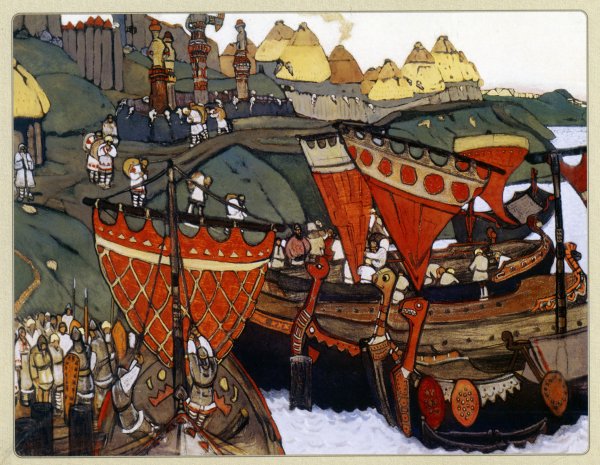
Nicholas Roerich
Slavs on the Dnieper
1905
The Slavs are the largest family of peoples in Europe and one of the largest in Asia. Peoples did not immediately form from individual tribes, and some, including numerous Slavic tribes, disappeared altogether.
Glade, who lived along the banks of the middle reaches of the Dnieper, formed the basis of the population Kievan Rus. The Ilmen Slovenes were the core of the Novgorod Republic. Krivichi - the ancestors of Smolensk - were the defenders of the western borders of the Slavic lands. The descendants of the Volhynians and Buzhans, who lived along the banks of the Western Bug and Volyn rivers, live there to this day. The capital of the Vyatichi was the city of Vyatka. The descendants of the Drevlyans live in Polissya - Ukrainian and Belarusian ...
Recently, Ukrainian archaeologists conducted excavations in Korosten - this is the name of the capital of the Drevlyans Iskorosten - and did a lot important discoveries. And the Dregovichi, the inhabitants of the once glorious Principality of Turov, are less noticeable against the general Slavic background. “dissolved” among others Slavic peoples and the tribes of Radimichi, Severyans, Ulichs and Tivertsy.
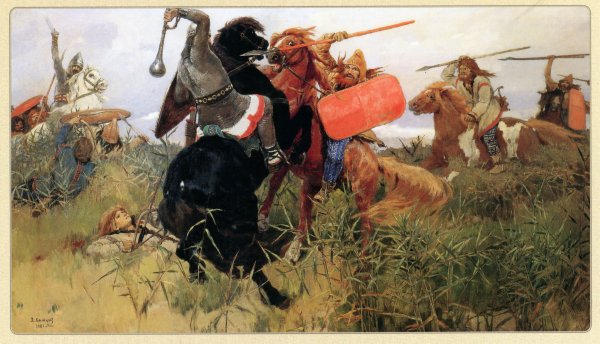
Viktor Vasnetsov
Battle of the Scythians with the Slavs
1881
The painting depicts a battle between Russian knights and nomads. How to distinguish Russians from the steppes?
Russians have metal helmets and chain mail, and weapons are forged or upholstered in metal - swords and a heavy mace. And the Russians also had red shields, pointed downwards. The nomads did not have iron armor, and when should they mine, smelt and forge metal if they are on the road all the time? The cattle breeders also had clothes for the most part made of leather, which they brightly dyed. Hair was dyed with henna, and everyone seemed red.
The steppes preferred to fight with short spears with metal tips: they stabbed the enemy or threw them at a short distance. And, of course, they used bows.
The Slavs led a settled way of life, and the nomads grazed cattle and lived by robbery. They will plunder and ride off into the endless steppe.
This fight took place on the border. In a skirmish, apparently, the Russian soldiers win, although there are fewer of them. In the background, a Russian warrior cuts a shield with a sword, behind which two people hid. The leather shield is about to shatter into pieces. What to do? It would be faster to escape from the borders of Russia.
According to historical ideas of the beginning of the 20th century, the artist called the nomads Scythians. Today it is already known that the Slavs did not intersect with the Scythians in the historical space.

Unknown artist
Bargaining among the ancient Slavs
The painting depicts Slavic bargaining on the Dnieper River. From which only the merchants came, no matter what they brought!
One should not be surprised at such a variety of goods, outfits, languages, “currencies”: several important trade routes passed through the Slavic lands. The main route is “from the Varangians to the Greeks”, that is, from Scandinavia to Byzantium. Not only Swedes, Norwegians and Danes traveled to the south, but also merchants from all Northern European countries.
And the Byzantine Greeks hurried north. Their target was not necessarily the countries located on the shores of the Baltic Sea. They could sell their goods to the Slavs, buy from them the skins of wild animals, honey, products of blacksmiths and potters, and return home to sell goods from the banks of the Dnieper on the banks of the Bosphorus with great profit. It was possible to trade in the products of the Slavs in Scandinavia ... There were many merchants, and therefore the merchants, despite the dangers that lay in wait for them on their distant wanderings, hurried on their way.
There was another way - "from the Varangians to the Persians." Merchants sailed from the north along the Volga to the Caspian Sea. And in the opposite direction.
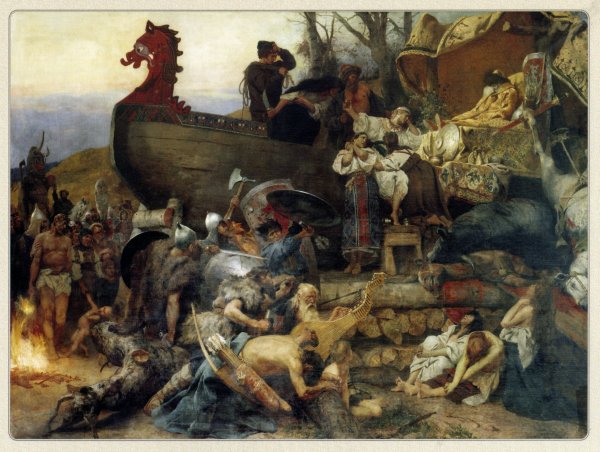
Henryk Semiradsky
The funeral of a noble Rus
In the summer of 921, Arab diplomats set off from Baghdad to Volga Bulgaria to establish good relations between the two countries. The delegation included a secretary - Ahmad Ibn Fadlan. He diligently described everything he saw during the journey. And he saw a lot of things that many did not know either before or after him.
On the banks of the Volga, Ibn Fadlan met the Rus, our ancestors. He described their appearance and customs. He told in particular detail how the Rus buried a noble tribesman. The Russians cut a huge boat for the deceased, put everything that was dear to him in life, and then set fire to the boat along with the body and all the good. To the question of Ibn Fadlan why they do this, one of the Rus explained:
“You Arabs take the deceased, the person you love most, the most respected by you, and throw him into the ground, and the worms eat his ashes, and we burn him in the twinkling of an eye, so that he enters paradise immediately.”
The description of the ancient rite was made by an Arab traveler so precisely and in detail that ten centuries later the artist Heinrich Ippolitovich Semiradsky was able to depict it in his picture.

Claudius Lebedev
Night on Ivan Kupala
Among the Eastern Slavs, Kupala was the main character of the summer solstice holiday - that was the name of the scarecrow. During the holiday, he was “bathed”, that is, drowned in the river - hence the name. And when the Slavs adopted Christianity, this holiday was timed to coincide with the birthday of John the Baptist, who was popularly called Ivan Kupala, he baptized Jesus Christ in the Jordan River.
Although the holidays coincided, they did not mix into one. Many pagan beliefs and customs have survived. On this holiday of herbs, water and divination, the girls wove wreaths and floated them on the water: it is important that the wreath, picked up by the current, float away far, far away, where the future groom will find it. On the night of Ivan Kupala, they jumped over the fire to burn all sins.
People believed that only on this night the fern blossomed. The flower seems to glow in the dark. Whoever can find it and carry it out of the forest will find happiness. The flower will indicate where the treasure is buried. With a flower you need to leave without looking back. If you look around, evil spirits will snatch a valuable plant from your hands, and a person will find himself in darkness, in which you can easily disappear. Many beliefs of this holiday are described by Nikolai Vasilyevich Gogol in the story “Evening on the eve of Ivan Kupala”.

Viktor Vasnetsov
Varangians
1909
The picture depicts the calling of the Varangians of Russia by the Novgorodians - Rurik, Sineus and Truvor, described much later in The Tale of Bygone Years. The chronicle of Nestor says that the Ilmen Slovenes (lived along the shores of Lake Ilmen), the Krivichi and their Finno-Ugric neighbors - the Chud - lived richly, but could not agree on anything. And then they decided to send messengers across the sea and call on the Russian prince Rurik and his two brothers, Sineus and Truvor, experienced sailors and warriors, seasoned in battles. They could rule honor by honor. They called them "Rus". From the Varangians, called from across the sea by the Slavs, Chud and Krivichi, in order to stop civil strife and strife, the Russian land was nicknamed.
Behind the brothers you can see the ships on which they sailed to the Novgorodians. In the middle stands Rurik, to the right of him is the middle brother Sineus. On the other side of Rurik is the younger brother Truvor.
On the right are Novgorodians - Ilmenian Slovenes. They have long hair and beards, they are in linen homespun shirts and fur-lined coats. They laid out gifts for the guests - expensive furs and honey in pots. Among the Novgorodians, a gray-haired man stands out tall man. Probably, this is a Novgorod posadnik - the elected head of the city. Maybe he says to the Varangians: “Our land is great and plentiful, but there is no order in it. Come reign and rule over us."
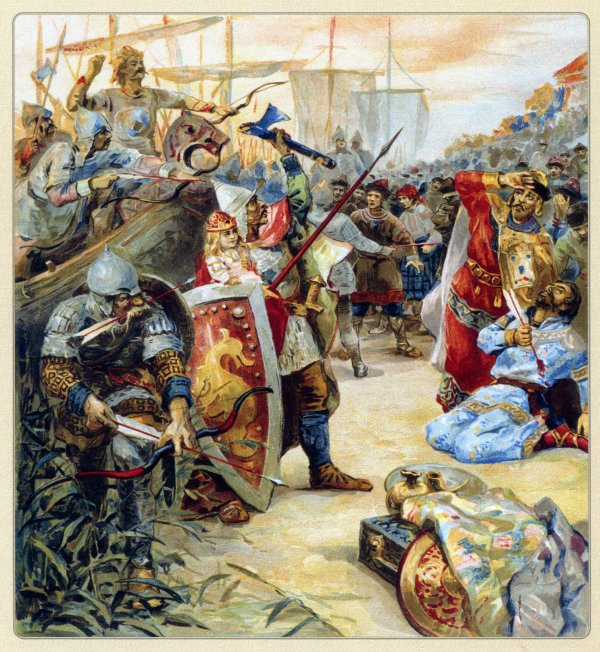
Unknown artist
The murder of Askold and Dir by Oleg
It is known from ancient chronicles that the Ilmen Slovenes (Novgorodians) and the Finno-Ugric peoples said: "Our land is great and plentiful, but there is no order in it," and therefore they invited Prince Rurik to rule them. While Rurik and his two brothers were putting things in order in northern lands, two of his combatants, the Varangians Askold and Dir, went south, on a campaign against Tsargrad. Then there was no ruler in Kyiv, and the people of Kiev decided: let the Varangians rule them.
Rurik's brothers died childless. Leaving Igor as heir, Prince Rurik himself died. Igor was still a boy and could not rule on his own, look after him and help him. Rurik asked Oleg.
In 882, Prince Oleg of Novgorod gathered an army and went south by water, occupying Smolensk and Lyubech, and descended to Kyiv. According to the chronicle, Oleg accused Askold and Dir that they illegally appropriated power over Kyiv, because they did not belong to the called Varangian family. Askold and Dir were killed.
Until now, there is a monument in Kyiv - Askold's grave.
And in Kyiv, Oleg first ruled, and when Igor grew up, power passed to him. This is how the state of Kievan Rus arose.

Nicholas Roerich
Prince hunting. Morning.
1901
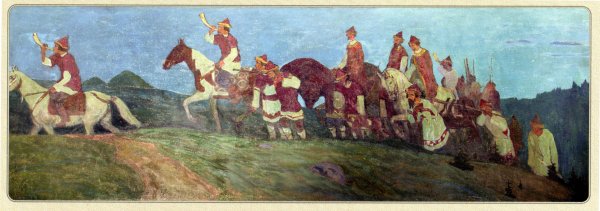
Nicholas Roerich
Prince hunting. Evening.
1901
People have hunted since ancient times. Not just for food: hunting was considered best school education of warriors. All the great princes, and then the kings of the Rurik family were avid hunters.
The first of the princes who was mentioned as a hunter was Igor Rurikovich. Not only a warrior, but also a hunter was his son Svyatoslav. Of the twelve sons of Vladimir Svyatoslavich, two were passionate hunters.
Yaroslav Vladimirovich the Wise described how, whom and with what he hunted. If the eastern lords preferred to shoot the victim with a bow, then the Russian princes met with the beast one on one. One prince balanced the chances of winning in the fight with the beast with the help of a sword, another preferred long hunting knives, and others went out to a bear or a wild boar with a horn.
Vladimir Monomakh did not consider hunting a cruel pastime. He wrote: "All the same, God gave it for the sake of man, for food, for fun." Yes, and there were a lot of living creatures in those days in our forests and fields, and there were so many fish in the rivers that you can catch as much as you want, it will not become less.
Hunting was divided into canine and falconry. The picture shows a dog hunt - with dogs that smelled an elk.

Nikolai Bodarevsky
Prince Oleg nails his shield to the gates of Constantinople
In the center of the picture is a warrior in armor - this is Prince Oleg of Kyiv. He watches as, on his orders, a warrior hammers a nail into the stone wall above the arched city gates. The second warrior - he also climbs the steps of the stairs - holds a red combat shield.
It was in 911 at the gates of the capital of the Byzantine Empire, Constantinople, which in those days was called Constantinople. Prince Oleg of Kyiv and his retinue went on a military campaign to the south. The Byzantine emperor Leo VI the Wise ordered the gates of the city to be closed and the harbor to be blocked with chains, so that it was impossible to approach or swim to the city. Oleg, according to legend, ordered the ships to be taken out of the water, put on wheels - and raise the sails!
The wind blew, and the ships rolled straight to the walls of the city. When the Byzantines saw the ships, they were frightened by an unprecedented sight, they immediately offered Oleg to conclude a peace treaty and pay tribute. The prince received 12 hryvnias for the ship and orders for the Russian cities in which Oleg's men were imprisoned. And in order for the Byzantines not to forget their promise, Oleg ordered a shield to be nailed over the entrance to Constantinople.

Viktor Vasnetsov
Oleg's farewell to the horse. Illustration for the poem by A.S. Pushkin "Song of the Prophetic Oleg"
1899
In this picture, Prince Oleg says goodbye to his beloved horse. And the horse lowered his head, and his master barely holds back his tears. And you need to part: the sorcerer-seer told the prince that he would die from his horse. Oleg ordered to take the horse to the stable, look after him there, feed him plenty, do not forget to take him out for a walk, but do not show the horse to the owner again.
They said goodbye, and the prince went on a military campaign on another horse. For many years he fought, often won battles, and when he returned home with rich booty, he asked if his comrade-in-arms was alive. “It has been several years since he died,” the grooms replied.
“The sorcerer deceived me,” the prince sighed, “I could not part with my horse for a long time. Where are his bones? he asked the grooms.
Oleg followed them and saw white bones. He stepped on the skull of a horse, and from there a poisonous snake crawled out and stung Oleg. Soon the prince died.
The sorcerer's prediction came true: Oleg accepted death from his horse.

Viktor Vasnetsov
Accordion. Trizna.
1910
In ancient times, it was customary to arrange feasts for the dead soldiers - memorial meals, at which heroic songs about the exploits of the dead soldiers were sung. Here, too, we see how his squad is located on the grave of Prince Oleg.
The guslar-narrator sings to warriors and princes a song about glorious old times. Many nations had such storytellers. The Irish called them "bards", the Greeks called them "aeds". The most famous Russian storyteller was Bayan (in the old days - Boyan). He is mentioned in the "Word of Igor's Campaign", there is a record about him on the wall of St. Sophia of Kyiv. And in Veliky Novgorod there is Boyana Street.
The name of this singer comes from the word "bayat" - "say". Boyans were once called outstanding poets and performers. This name is common among the Bulgarians and Turkic peoples, whose ancestors were nomads.
Bayan is called “prophetic” in “The Word…”: he sang songs and foreshadowed the future. But he cannot be called a fortuneteller: Bayan was a great mentor of princes and people from the people. His songs called for the unification not only of the Russian principalities, but of all Slavic peoples.
Monuments to the ancient storyteller have been erected in Trubchevsk and Novgorod-Seversky.

Viktor Vasnetsov
Guslars
1899
Gusli - stringed musical instrument. Its sound, melodiousness corresponds to the Russian character, and therefore there were many famous guslars in Russia.
The ancient Greeks played the cithara, the Armenians enjoy the sounds of their canon, the Iranians prefer the santur, the Finns would not exchange the kantele for anything, and the Lithuanians - the kankles...
Back in the 9th century, the Slavs surprised Byzantine emperors by playing the harp. The harp was made from dugout dry boards of spruce or maple. The type of maple Yavor is especially loved by musical masters. From here comes the name of the gusli - “Yarovchatye”. And as soon as the strings began to be pulled from metal, the psaltery rang and began to be called “voiced”.
From epics we know the name of the gusliar and the Novgorod merchant Sadko. The hero Dobrynya Nikitich also played the harp. The robber Nightingale Budimirovich also liked to hit the strings.
But Bayan, the best gusler of Kievan Rus, surpassed all. He was also a prophetic storyteller.
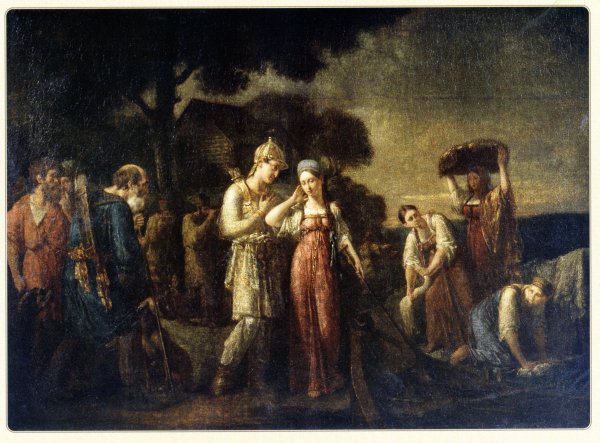
Vasily Sazonov
The first meeting of Prince Igor with Olga
The son of Rurik and his heir, the future great Kyiv prince Igor, met the Pskovite Olga and fell in love with her. According to legend, Olga was a simple peasant woman - the daughter of a carrier across the river. At the crossing, Igor saw the girl, and her beauty captivated him. The wedding took place later, when, at the request of Igor, his bride was brought to the capital of Kievan Rus.
Scientists are still arguing about who Princess Olga was by origin and in what year she married Igor. Some researchers claim that she was a princess, possibly of Scandinavian origin.
In 945, returning from polyudya to Kyiv, Igor decided to impose a second tribute on the Drevlyans. First, ambassadors were sent to the prince, who reminded him that all the tribute had already been collected. When Igor did not give in and insisted on re-gathering polyudy, he was captured and brutally executed.
Princess Olga remained a widow and ruled the country alone on behalf of her young son, Svyatoslav Igorevich. So she became the first Russian female ruler. First of all, she cruelly repaid the murderers of her husband, whom she loved very much and whose son, Svyatoslav, she raised.
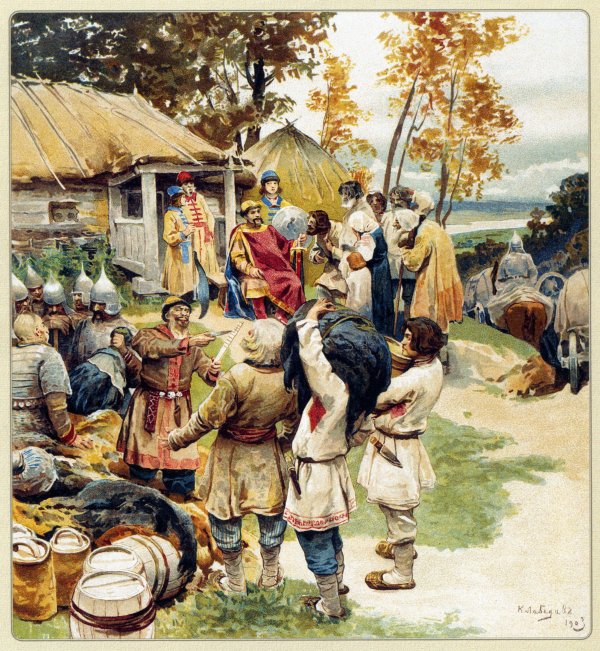
Claudius Lebedev
Polyudie. Prince Igor collects tribute from the subject Drevlyans near Iskorosten in the fall of 945
1903
Collection of tribute under Prince Igor. Peasants, artisans and hunters had to share their wealth with the prince. Products and products went to the maintenance of the squad, which protected the subjects from enemy raids. In addition, the warriors made military campaigns, expanding the prince's possessions. The peasants, in particular, the Drevlyans, did not participate in these campaigns and battles: they plowed the land and harvested. There were tribute norms, but the peasants often stole food from the tribute collectors.
After an unsuccessful campaign against Byzantium, Igor's warriors began to complain that they were impoverished and wanted to go to the Drevlyans for tribute.
In 945, the prince with a retinue went to Iskorosten, the Drevlyansk capital. When the tribute was collected, Igor sent part of the army home, and with a smaller part he decided to return for a new tribute. The Drevlyans, having learned about this, told their prince Mal: “If a wolf gets into the habit of sheep, he will carry out the whole herd until they kill him. So is this one: if we do not kill him, then he will destroy us all.” Mal agreed with the decision of the subjects. After that, the Drevlyans left the city, stopped Igor on the road and dealt with the prince and his soldiers.
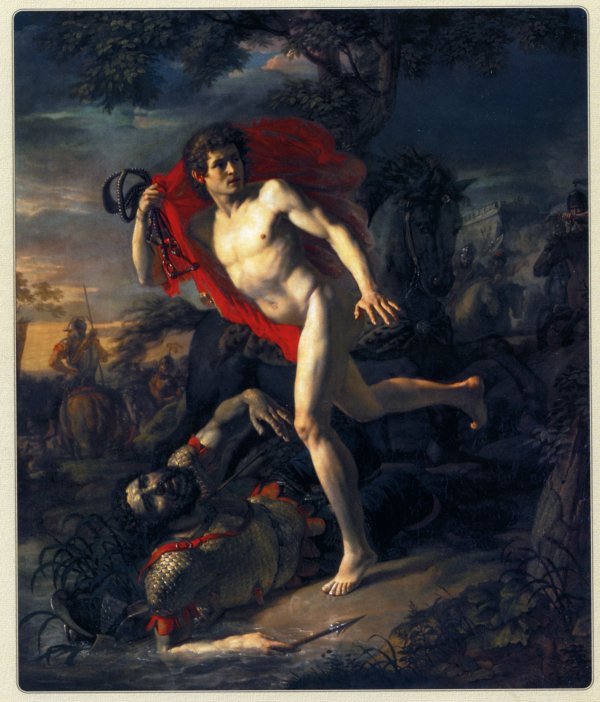
Andrey Ivanov
The feat of a young Kyivian during the siege of Kyiv by the Pechenegs in 968.
Around 1810
Prince Svyatoslav went on a campaign against the Bulgarian kingdom. There was no governor Pretich in Kyiv either - he was on the other side of the Dnieper. The Pechenegs decided that it was time to take revenge on the people of Kiev for the defeat.
Princess Olga decided to send a young man who knew the language of the Pechenegs as a messenger. He had to go through the ranks of enemies, swim across the Dnieper and find Pretich. The princess said that if the young man did not bring help in the morning, she would order the surrender of the city.
In the evening, a young resident of Kiev secretly got out of the city. He wandered from one fire to another and asked in the Pecheneg language if anyone had seen his horse. The warriors only brushed it off - they say, he missed it, and look for it yourself. The guy got to the water and swam to the opposite shore. Only then did the Pechenegs realize that they had let a messenger out of the city.
Having received a message from the princess, the voivode ordered to immediately set out on a campaign. With the sunrise, the army was already on the other side of the river. But the squad is small, and the Pechenegs are a whole army. Then Pretich ordered to blow the trumpets, beat the drums - make a noise so that the Pechenegs decide: Svyatoslav has returned. The siege was lifted, and the townspeople were saved thanks to the courage of the young Kyivian, whose name no one ever found out.
![]()
Ivan Akimov
Grand Duke Svyatoslav kissing his mother and children upon his return from the Danube to Kyiv.
1773
Grand Duke Svyatoslav is the son of Prince Igor and Olga. A description of his appearance has been preserved: “He was of medium height, rather slender, but gloomy and wild in appearance, had a wide chest, a thick neck, blue eyes, thick eyebrows, a flat nose, a long mustache, a sparse beard, and one tuft of hair on his head, in a golden earring adorned with two pearls and a ruby hung in his ear as a sign of his nobility.
Svyatoslav was a warrior, went to the Bulgarians. The return from this campaign is depicted in the picture. While Princess Olga was left alone with her grandchildren in Kyiv, hordes of Pechenegs approached the city. But thanks to the feat of a Kyivian, Svyatoslav received news of the impending danger in time, managed to return to Kyiv and save the city.
The picture is made in an academic manner. Svyatoslav on her looks more like a Roman soldier than a Russian prince. This is easy to explain: historical science in 1773, in which this picture was written, had just turned its attention to Russian history.

Claudius Lebedev
Meeting of the Kyiv prince Svyatoslav with the Byzantine emperor Ivan Tzimiskes.
Shortly after the Danube campaign of Svyatoslav, Kyiv was surrounded by the Pechenegs, and Grand Duke was forced to return to the defense of the capital. Having beaten off the Pechenegs, he again returned to Bulgaria, and around 971, in alliance with the Bulgarians and Hungarians, he began a war with Byzantium. After a battle with a superior army at Bolshoi Preslav and Dorostol, the Russian army withstood a three-month siege. And in 971 Svyatoslav Igorevich made peace with Byzantium.
The painting by Claudius Lebedev depicts the meeting of the Grand Duke Svyatoslav Igorevich with the Byzantine Emperor Tzimiskes after the conclusion of a peace treaty. According to the description of the eyewitness historian Leo the Deacon, he sailed to meet the emperor in a boat, and he worked with an oar along with other rowers. The Kyiv prince was dressed in a simple shirt, but in his ear was an earring with two pearls and a ruby.
On the way back, already at the Dnieper rapids, Svyatoslav was killed by the Pechenegs waiting for him in ambush.

Andrey Ryabushkin
Feast of heroes at the affectionate Prince Vladimir
1888
At the feast of the heroes, hosted by Grand Duke Vladimir Svyatoslavich, he and the princess are sitting in the right corner, and on the left side of the picture we see a storyteller with a harp. He bows to the prince, thanks for the treat and, it seems, is ready to perform an epic about the exploits of heroes.
The writer Konstantin Aksakov said: “Grand Duke Vladimir, kind and affectionate, hospitable and feasting, constantly surrounded by guests and heroes who came from all sides of the Russian land, connecting all of them around him and pleasing everyone with greetings and festivity, remained alive in memory and songs folk with their constant epithet "Red Sun", an epithet that expresses the beneficial and at the same time all-Russian significance of the Grand Duke Vladimir.
To this it must be added that the feast is not only a feast, but also an ancient, carefully designed ritual, in which there were no trifles. It was necessary to know firmly what days feasts could be held, how long they should last, and most importantly, how to properly seat guests. The owner had to know what dishes and in what order to serve on the table ... The slightest mistake could mortally offend the guest.
The ritual of Russian feasts was canceled by the assemblies introduced by Peter I, which had other orders that had no roots in Russian culture.
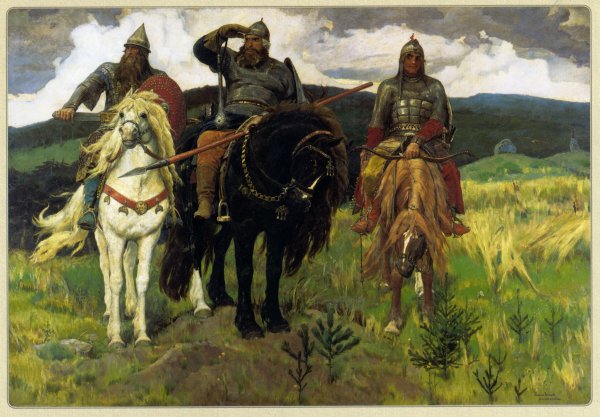
Viktor Vasnetsov
Bogatyrs
1898
In the famous painting “Bogatyrs” there are three mighty knights, the defenders of Russia, the “heroic outpost”. In the center - Ilya Muromets. To his left is Dobrynya Nikitich on a white horse. On the right is Alyosha Popovich. They became a symbol of the unity of the Russian lands: Dobrynya - from Ryazan, Ilya - from Murom, Alyosha - from Rostov. There are also symbols of Light and Darkness in the picture: Alyosha - like Zorenka Yasnaya, Dobrynya Nikitich - White Day, and Ilya - Dark Night. Three masculine forces: gallant prowess, the irresistible power of maturity and the experience of older age. But were these heroes really? Of course they were! Dobrynya Nikitich is the uncle of Grand Duke Vladimir, who baptized Kyiv, and Dobrynya baptized Novgorod.
Ilya Muromets guarded the borders of Kievan Rus, and then became a monk of the Kiev Caves Monastery. Therefore, Ilya was buried in the Near Caves of the Lavra.
About the adventures of the son of a Rostov priest, the mischievous Alyosha Popovich, many epics are composed.

Viktor Vasnetsov
Knight at the Crossroads
1882
The artist Viktor Vasnetsov called this picture “The Knight at the Crossroads”. It is believed that the epic hero Ilya Muromets is depicted on it. He was born in the village of Karacharovo, but for thirty-three years he could not walk. But passersby Kaliki came to him, cured him, and even endowed him with heroic strength. A sword, armor and a suitable horse were found for the hero. He saddled a horse and went to do good deeds, to fight evil spirits. But suddenly a stone blocked his path. Something is written on it, but it cannot be read on the picture: some of the letters have been erased, while others have grown with moss.
The artist in a letter to a friend said that the stone says: “How to go straight - I live not to be - there is no way for a passer-by, or a passer-by, or a flyby. To the right to go - to be married; go to the left - be rich."
This is the main test for the knight: which road to choose? If he gets married, he will not be up to exploits: he will live at home with his beloved wife. A rich man also has no need to ride a horse across an open field, he would have to count and increase his wealth. And the one who is not afraid of death and will go straight is a real hero.

Evgraf Sorokin
Jan Usmowiec holding a bull
1849
The most famous heroes in Russia are Ilya Muromets, Dobrynya Nikitich, Alyosha Popovich. But there were others - among them Jan Usmovets.
In 992, the Pechenegs came to Russia and began to boast of their strength. Two troops gathered before the battle: Russian and Pecheneg. The chief Pecheneg says: let, they say, a Russian strongman come out and measure his strength with our hero. But no one was in a hurry to go to the duel first. Prince Vladimir was afraid that he would have to admit defeat. But then one old man said that his younger son is so strong that he tears the skin of a bull. We decided to test the strongman. The beast is running - it is about to raise the young man on the horns! At the last moment, Yang stepped aside and grabbed the bull's side with one hand. So much so that he could not escape. And when he nevertheless escaped, a piece of a bull's skin remained in Jan's hand.
The Pechenegs saw this and understood: the Russian hero is stronger than their duel. And so they went to their steppes.
In the place where Yang showed his strength, they built a city and called it Pereyaslav. They called it that because Yan Usmovets intercepted - took over - the glory of the Pecheneg strongman.
Years passed, and people began to glorify the strength of Nikita Kozhemyaka: they also talked about the same case. Were these two different person Or one, I don't know. There were many strong heroes in Russia.

Vasily Perov
The first Christians in Kyiv
1880
The artist Vasily Perov depicted the first Christians in the then pagan capital of Kievan Rus - in the city of Kyiv. This meeting took place in the 9th century - before the Grand Duke Vladimir Svyatoslavovich baptized Russia. At that time, Christians did not yet have their own church and they had nowhere to pray to God. The first Christians were different peoples- Greek merchants, Scandinavian warriors or local Slavs: all were united by faith in the One God.
As shown in the picture, Christians gathered in a secluded place, in the evening, and read Holy Bible: pagans could see them during the day. But the darkness in the picture also has a symbolic meaning - it is the darkness of disbelief in God. And only a burning candle makes her retreat: this is the light of faith, which comes not only from the flame, but also from the Holy Scripture itself.
A little time will pass - and in Kyiv they will build the first stone Orthodox church, the Church of the Tithes, and light candles there, dispelling the darkness of unbelief. They will build a beautiful St. Sophia Cathedral. The Kiev-Pechersk Lavra will be founded, in which monks will begin to live: icon painters, healers, chroniclers. But it will be later, but for now, the first Kyiv Christians light their candle in the dark.
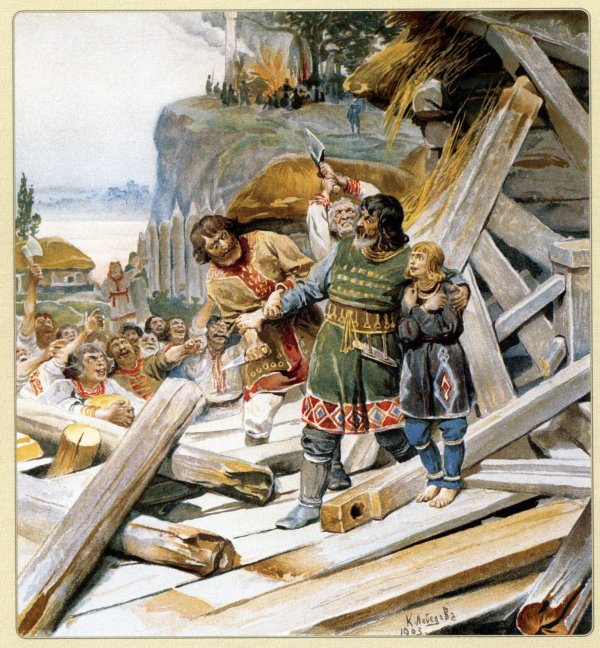
Claudius Lebedev
The killing of two Varangians
1903
The widow of Grand Duke Igor, Princess Olga, at the end of her life went to Constantinople, at the same time she was baptized. And her son, Prince Svyatoslav Igorevich, remained a pagan. He died in 972 or 073, when the Pechenegs attacked him at the Dnieper rapids. After the death of the Grand Duke, three sons remained: Yaropolk, Oleg and Vladimir. After his father, the eldest son, Yaropolk, became the Prince of Kyiv. He ruled for a short time - from 970 to 980. He, like his father, was also a pagan, but he was sympathetic to other beliefs. Under him, the first Christian churches began to be built in the lower, commercial part of the city. The Christians themselves built houses for themselves - they built where they wanted, including next to the princely fortress, the citadel. Pagan idols also stood there. Two baptized Varangians settled just in this place. After baptism, the father received the name Theodore, and the son was named John.
According to the chronicles, the wise men, dissatisfied with the fact that non-believers live next to their idols, set the people on them. When the Varangians locked themselves in the house, the pagans dismantled the structure piece by piece and killed its owners.
Theodore and John became the first Russian martyrs for the Orthodox faith.

Chromolithograph
Nestor the chronicler
Viktor Vasnetsov
Duchess Olga
1885-1896
Monk Nestor lived at the turn of the 11th and 12th centuries, and Princess Olga lived in the 10th century. They were separated by a century, and both of them are iconic figures in ancient history our state.
Nestor is a chronicler, the author of the well-known chronicle "The Tale of Bygone Years". From this historical work, we learn about how our state arose, how Russia was baptized, and about other important events. He is considered the author of "Reading about the life and destruction of Boris and Gleb" - a work about the first Russian saints, and "The Life of Theodosius of the Caves" - a description of the life of the founder of the Kiev-Pechersk Lavra, of which Nestor was a monk.
Princess Olga, widow of Prince Igor and mother of Prince Svyatoslav, became the first Russian princess to convert to Christianity. After baptism, she received a new name - Elena.
Princess Olga died in 969. Descendants preserved a good memory of her: it was not for nothing that the ancient chronicler called her “the herald of the Christian land”.
Her grandson, Prince Vladimir Svyatoslavich, according to some sources, in 1007 ordered to transfer the remains of the princess to the Church of the Tithes. They told about the miracles that took place near the tomb of Princess Olga. Many people were healed from diseases.






